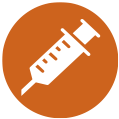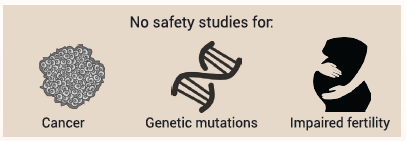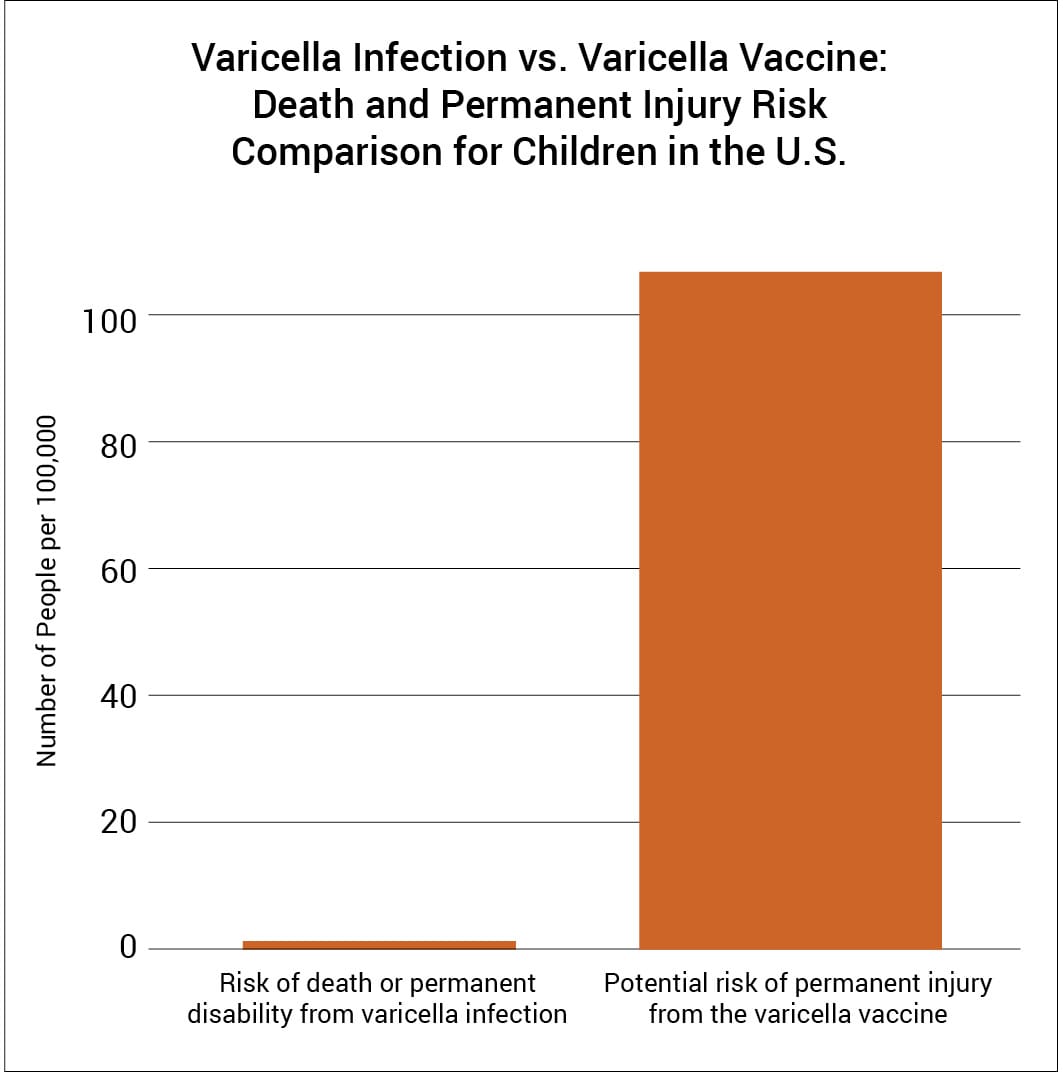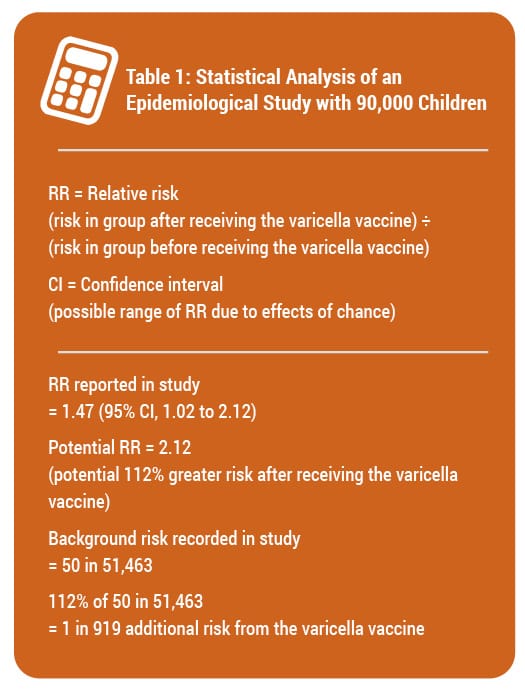Varicella Vaccine
Is It Safer Than Varicella (Chicken Pox)?
1. WHAT IS THE VARICELLA VACCINE?
The varicella vaccine was introduced in the U.S. in 1995. It has significantly reduced the incidence of reported cases of varicella infections; however, the Centers for Disease Control and Prevention (CDC) states, “It is not known how long a vaccinated person is protected against varicella.”1
 2. WHAT ARE THE SIDE EFFECTS?
2. WHAT ARE THE SIDE EFFECTS?
Common side effects of the varicella vaccine include fever, flu-like symptoms, and varicella-like rash.2 A more serious potential side effect is seizure, which may occur in about 1 in 940 children vaccinated with varicella vaccine.3-6 Although severe adverse events have been observed following vaccination with varicella vaccine, including neurological disorders (e.g., encephalopathy, cerebellar ataxia, transverse myelitis, Guillain-Barré syndrome, and small fiber neuropathy), autoimmune diseases (e.g., arthropathy and thrombocytopenia), and stroke, the Institute of Medicine (IOM) states that “the evidence is inadequate to accept or reject a causal relationship between varicella vaccine” and those conditions.7 The IOM also found that the “evidence convincingly supports a causal relationship between varicella vaccine and vaccine-strain viral reactivation.” Therefore, similar to natural infection with varicella, vaccine-strain virus can be reactivated and cause herpes zoster (shingles). However, the IOM states, “the rate of shingles and other infection-related adverse events associated specifically with the varicella vaccine virus are not known… [W]hile the rate of shingles can be estimated…in most cases the virus is not characterized, meaning no test is done to determine whether the virus is wild or vaccine type.”7 Additionally, the manufacturer’s package insert states that the varicella vaccine “has not been evaluated for its carcinogenic or mutagenic potential, or its potential to impair fertility.”2

 3. HOW ARE RISKS OF VACCINE SIDE EFFECTS MEASURED?
3. HOW ARE RISKS OF VACCINE SIDE EFFECTS MEASURED?
Methods to measure vaccine risks include surveillance systems, clinical trials, and epidemiological studies.
 4. HOW ACCURATE IS SURVEILLANCE OF ADVERSE EVENTS FROM THE VARICELLA VACCINE?
4. HOW ACCURATE IS SURVEILLANCE OF ADVERSE EVENTS FROM THE VARICELLA VACCINE?
The government tracks reported cases of vaccine side effects through the Vaccine Adverse Event Reporting System (VAERS). Approximately 33 cases of permanent injury or death from the varicella vaccine are reported to VAERS annually.8 However, VAERS is a passive reporting system — authorities do not actively search for cases of vaccine injury and do not actively remind doctors and the public to report cases. These limitations can lead to significant underreporting of vaccine injury.9 The CDC states, “VAERS receives reports for only a small fraction of actual adverse events.”10 Indeed, as few as 1% of serious side effects from medical products are reported to passive surveillance systems.11 In addition, VAERS reports are not proof that a side effect occurred, as the system is not designed to thoroughly investigate all cases.12 As a result, VAERS does not provide an accurate count of varicella vaccine side effects.
 5. HOW ACCURATE ARE CLINICAL TRIALS OF THE VARICELLA VACCINE?
5. HOW ACCURATE ARE CLINICAL TRIALS OF THE VARICELLA VACCINE?
The CDC states, “Prelicensure trials are relatively small — usually limited to a few thousand subjects — and usually last no longer than a few years… Prelicensure trials usually do not have the ability to detect rare adverse events or adverse events with delayed onset.”9 Because the risk of contracting a fatal case of varicella in the U.S. is about 1 in 40,000 in the absence of mass vaccination,13 a few thousand subjects in clinical trials are not enough to prove that the varicella vaccine causes less permanent injury or death than varicella (Fig. 1).

Figure 1: There are not enough subjects in clinical trials to prove that the varicella vaccine poses less risk than varicella.
6. HOW ACCURATE ARE EPIDEMIOLOGICAL STUDIES OF THE VARICELLA VACCINE?
Epidemiological studies are hindered by the effects of chance and possible confounders — additional factors that could conceivably affect the groups being studied. For example, a study published in The Pediatric Infectious Disease Journal involving about 90,000 children looked for an association between the varicella vaccine and certain adverse events.14 The study found a statistically significant association between the varicella vaccine and several adverse events. Although the significance may have resulted from confounders, the study did not rule out the possibility that the varicella vaccine increases the risk of an adverse event that leads to permanent injury by up to 112%. Consequently, the study did not rule out the possibility that such adverse events might occur up to 44 times more often than fatal varicella: 1 in 919 compared to 1 in 40,000 (Fig. 2 and Table 1). The range of possibilities found in the study makes the result inconclusive; even large epidemiological studies are not accurate enough to prove that the varicella vaccine causes less permanent injury or death than varicella.
![]()
7. IS THE VARICELLA VACCINE SAFER THAN VARICELLA ?
It has not been proven that the varicella vaccine is safer than varicella. The vaccine package insert raises questions about safety testing for cancer, genetic mutations, and impaired fertility. Although VAERS tracks some adverse events, it is too inaccurate to measure against the risk of varicella. Clinical trials do not have the ability to detect less common adverse reactions, and epidemiological studies are limited by the effects of chance and potential confounders. Safety studies of varicella vaccines are lacking in statistical power. A review of varicella vaccine safety studies conducted by the IOM found that the evidence was inadequate to rule out the possibility that varicella vaccination leads to several neurological and autoimmune disorders.7 Because permanent sequelae (aftereffects) from varicella are so rare, the level of accuracy of the research studies available is insufficient to prove that the varicella vaccine causes less permanent injury or death than varicella.

Figure 2: A study published in The Pediatric Infectious Disease Journal did not rule out the possibility that the varicella vaccine can cause an adverse event leading to permanent injury 44 times more often than varicella can be fatal or cause permanent disability in the U.S.

REFERENCES
- Centers for Disease Control and Prevention. Washington, D.C.: U.S. Department of Health and Human Services. About the varicella vaccines; [cited 2023 April 7]. https://www.cdc.gov/vaccines/vpd/varicella/hcp/about-vaccine.html.
- Merck Sharp & Dohme, Corp. Whitehouse Station (NJ): Merck & Co, Inc. Varivax Refrigerated: Varicella Virus Vaccine Live (Oka/Merck); 2016 Sep 02. 8-12. https://physiciansforinformedconsent.org/merck-varivax-refrigerated-varicella-virus-vaccine-live.
- Between 2000 and 2004, the Vaccine Adverse Event Reporting System (VAERS) received 422 reports of seizure-related adverse events involving varicella vaccine in children 1-2 years of age.4 In the same time period, VAERS received 618 reports of seizure-related adverse events involving measles vaccine in children 1-2 years of age.5 This suggests that seizures from varicella vaccine may occur 68% as often as seizures from MMR vaccine, 68% of 1 in 6406 or about 1 in 940.
- Centers for Disease Control and Prevention. Washington, D.C.: U.S. Department of Health and Human Services. CDC wonder: about the Vaccine Adverse Event Reporting System (VAERS); [cited 2023 April 14]. https://wonder.cdc.gov/vaers.html. Query for seizure-related events involving varicella vaccine, 2000-2004.
- Centers for Disease Control and Prevention. Washington, D.C.: U.S. Department of Health and Human Services. CDC wonder: about the Vaccine Adverse Event Reporting System (VAERS); [cited 2022 October 20]. https://wonder.cdc.gov/vaers.html. Query for seizure-related events involving all measles-containing vaccines, 2000-2004.
- Vestergaard M, Hviid A, Madsen KM, Wohlfahrt J, Thorsen P, Schendel D, Melbye M, Olsen J. MMR vaccination and febrile seizures: evaluation of susceptible subgroups and long-term prognosis. JAMA. 2004 Jul 21;292(3):356. https://jamanetwork.com/journals/jama/fullarticle/199117.
- Institute of Medicine (IOM). Adverse effects of vaccines: evidence and causality. Washington, D.C.: National Academies Press; 2012. 249-82. https://www.ncbi.nlm.nih.gov/books/NBK190024/pdf/Bookshelf_NBK190024.pdf.
- Centers for Disease Control and Prevention. Washington, D.C.: U.S. Department of Health and Human Services. CDC wonder: about the Vaccine Adverse Event Reporting System (VAERS); [cited 2022 April 19]. https://wonder.cdc.gov/vaers.html. Query for death and permanent disability involving varicella vaccine, 2000-2004.
- Centers for Disease Control and Prevention. Manual for the surveillance of vaccine-preventable diseases. 5th ed. Miller ER, Haber P, Hibbs B, Broder K. Chapter 21: surveillance for adverse events following immunization using the Vaccine Adverse Event Reporting System (VAERS). Atlanta: Centers for Disease Control and Prevention; 2011. 1,2,8. https://physiciansforinformedconsent.org/cdc-manual-for-the-surveillance-of-vaccine-preventable-diseases-5th-ed-chpt21-surv-adverse-events-2011.
- Centers for Disease Control and Prevention, Food and Drug Administration. Washington D.C.: U.S. Department of Health and Human Services. Guide to interpreting VAERS data; [cited 2022 May 28]. https://vaers.hhs.gov/data/dataguide.html.
- Kessler DA. Introducing MEDWatch. A new approach to reporting medication and device adverse effects and product problems. JAMA. 1993 Jun 2;269(21):2765-8. https://www.sciencedirect.com/science/article/abs/pii/0163834394900515?via%3Dihub.
- Centers for Disease Control and Prevention. Washington D.C.: U.S. Department of Health and Human Services. CDC wonder: about the Vaccine Adverse Event Reporting System (VAERS); [cited 2022 May 28]. https://wonder.cdc.gov/vaers.html.
- Centers for Disease Control. Epidemiology and prevention of vaccine-preventable diseases. 13th ed. Hamborsky J, Kroger A, Wolfe S, editors. Washington, D.C.: Public Health Foundation; 2015. 356, 359. https://physiciansforinformedconsent.org/cdc-pink-book-13th-edition-2015/; in the early 1990s, annually there were about 4 million cases of which 103 (1 in 40,000) were fatal.
- Black S, Shinefield H, Ray P, Lewis E, Hansen J, Schwalbe J, Coplan P, Sharrar R, Guess H. Postmarketing evaluation of the safety and effectiveness of varicella vaccine. Pediatr Infect Dis J. 1999 Dec;18(12):1041-6. https://pubmed.ncbi.nlm.nih.gov/10608621/.
Published 2023 Sep; updated 2024 Jul


